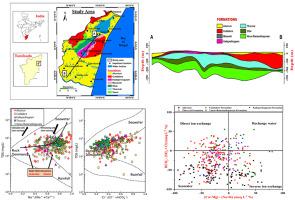印度本地治里地区复杂多层沿海含水层地下水适宜性的熵加权评价
IF 4.1
3区 地球科学
Q2 GEOSCIENCES, MULTIDISCIPLINARY
引用次数: 0
摘要
沿海地下水水质受到海水入侵的影响,并与地质和人为活动相结合,造成严重污染。早期的尝试是在本地切里(Pondicherry)多层沿海含水层中进行的,采用熵加权模型,通过计算熵饮用水质量指数(EDWQI)和熵灌溉水质指数(EIWQI)来评估地下水对饮用和灌溉设施的适宜性,并有限地关注工业用水的适宜性。本研究通过引入一种创新的熵加权技术来评估工业公用事业的地下水质量,采用熵加权工业水质指数(EIndWQI)来解决这一空白。从冲积层、Cuddalore、Kadaperikuppam、Thuruvai和Vanur-Ramanathapuram地层的多层含水层收集了376个地下水样本,并研究了主要的物理化学参数,包括阳离子和阴离子。水文地球化学分析结果表明,各含水层地下水以Na-Cl和Na-Ca-HCO3-Cl水类型为主。研究认为,冲积层和Cuddalore含水层主要受海水入侵、矿物溶解、污染地表水渗透和人类活动的影响。化学风化和阳离子交换过程影响了Kadaperikuppam、Thuruvai和Vanur-Ramanathapuram含水层的地下水化学。计算出的EDWQI建议冲积层(优良水质- 68.5%)到Vanur-Ramanathapuram地层(优良水质- 79.5%)的饮用水质量得到改善。EIWQI表明,Cuddalore含水层(水质优良- 97.5%)和Vanur-Ramanathapuram含水层(水质优良- 95.9%)非常适合灌溉。EIndWQI显示,Cuddalore(水质良好- 51.2%)、Thuruvai(水质良好- 76.7%)和Vanur-Ramanathapuram(水质良好- 53.1%)的地下水最适合工业使用。可以实施缓解战略,例如管理地下水抽取和改进水井安排。这项研究为各种公用事业管理地下水提供了有价值的投入。本文章由计算机程序翻译,如有差异,请以英文原文为准。

Entropy-weighted assessment of groundwater suitability in complex multi-layered coastal aquifers of Pondicherry, India
Coastal groundwater quality is influenced by seawater intrusion, and when combined with geogenic and human-induced activities, it results in severe contamination. Earlier attempts were made in the Pondicherry multi-layered coastal aquifers, adopting an entropy-weighted model by calculating the Entropy-Drinking Water Quality Index (EDWQI) and the Entropy-Irrigation Water Quality Index (EIWQI) to evaluate groundwater suitability for drinking and irrigational utilities with a limited focus on industrial water suitability. The present study addresses the gap by introducing an innovative entropy-weighted technique to assess the groundwater quality for industrial utility, adopting the Entropy-Weighted Industrial Water Quality Index (EIndWQI).
Three hundred seventy-six groundwater samples have been collected from the multi-aquifers of Alluvium, Cuddalore, Kadaperikuppam, Thuruvai, and Vanur-Ramanathapuram formations and investigated for major physicochemical parameters, including cations and anions. The outcomes of the hydrogeochemical analysis revealed that Na-Cl and Na-Ca-HCO3-Cl water types dominate the groundwaters of various aquifers.
The study infers that Alluvium and Cuddalore aquifers are primarily influenced by seawater intrusion, mineral dissolution, infiltration of contaminated surface waters, and human activities. The chemical weathering and cation exchange process impact the groundwater chemistry of Kadaperikuppam, Thuruvai, and Vanur-Ramanathapuram aquifers. The calculated EDWQI recommends improved drinking water quality from the Alluvium (Excellent water quality- 68.5 %) to Vanur-Ramanathapuram formations (Excellent water quality- 79.5 %). The EIWQI suggests that Cuddalore (Excellent water quality- 97.5 %) and Vanur-Ramanathapuram (Excellent water quality- 95.9 %) aquifers are highly suitable for irrigational practices. The EIndWQI shows that the groundwaters of the Cuddalore (Good water quality- 51.2 %), Thuruvai (Good water quality- 76.7 %), and Vanur-Ramanathapuram (Good water quality- 53.1 %) are optimal for industrial usage. Mitigation strategies, such as managed groundwater abstraction and improved well arrangements, can be implemented. This study provides valuable input for managing groundwater for various utilities.
求助全文
通过发布文献求助,成功后即可免费获取论文全文。
去求助
来源期刊

Physics and Chemistry of the Earth
地学-地球科学综合
CiteScore
5.40
自引率
2.70%
发文量
176
审稿时长
31.6 weeks
期刊介绍:
Physics and Chemistry of the Earth is an international interdisciplinary journal for the rapid publication of collections of refereed communications in separate thematic issues, either stemming from scientific meetings, or, especially compiled for the occasion. There is no restriction on the length of articles published in the journal. Physics and Chemistry of the Earth incorporates the separate Parts A, B and C which existed until the end of 2001.
Please note: the Editors are unable to consider submissions that are not invited or linked to a thematic issue. Please do not submit unsolicited papers.
The journal covers the following subject areas:
-Solid Earth and Geodesy:
(geology, geochemistry, tectonophysics, seismology, volcanology, palaeomagnetism and rock magnetism, electromagnetism and potential fields, marine and environmental geosciences as well as geodesy).
-Hydrology, Oceans and Atmosphere:
(hydrology and water resources research, engineering and management, oceanography and oceanic chemistry, shelf, sea, lake and river sciences, meteorology and atmospheric sciences incl. chemistry as well as climatology and glaciology).
-Solar-Terrestrial and Planetary Science:
(solar, heliospheric and solar-planetary sciences, geology, geophysics and atmospheric sciences of planets, satellites and small bodies as well as cosmochemistry and exobiology).
 求助内容:
求助内容: 应助结果提醒方式:
应助结果提醒方式:


